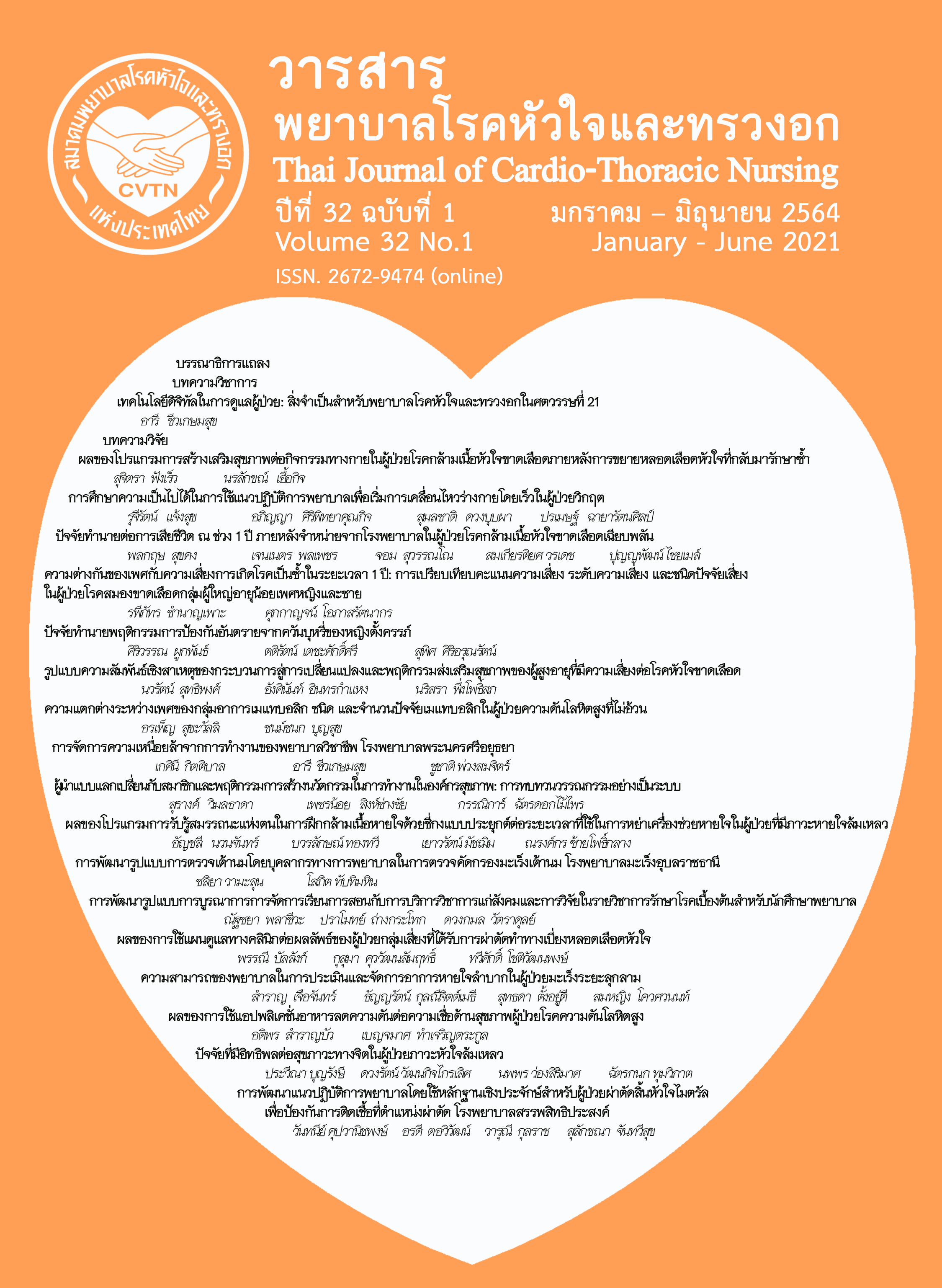ผลของโปรแกรมการสร้างเสริมสุขภาพต่อกิจกรรมทางกายในผู้ป่วยโรคกล้ามเนื้อหัวใจขาดเลือดภายหลังการขยายหลอดเลือดหัวใจที่กลับมารักษาซ้ำ
คำสำคัญ:
กิจกรรมทางกาย, ผู้ป่วโรคกล้ามเนื้อหัวใจขาดเลือด, การขยายหลอดเลือดหัวใจ, กลับมารักษาซ้ำ, โปรแกรมสร้างเสริมสุขภาพบทคัดย่อ
การวิจัยแบบกึ่งทดลอง มีวัตถุประสงค์เพื่อศึกษาผลของโปรแกรมการส่งเสริมสุขภาพต่อกิจกรรมทางกายในผู้ป่วยโรคกล้ามเนื้อหัวใจขาดเลือดภายหลังการขยายหลอดเลือดหัวใจที่กลับมารักษาซ้ำ กลุ่มตัวอย่าง คือ ผู้ป่วยกล้ามเนื้อหัวใจขาดเลือดภายหลังการขยายหลอดเลือดหัวใจกลับมากลับมารักษาซ้ำ เพศชายและหญิง อายุ 18-59 ปี ณ โรงพยาบาลศิริราช มหาวิทยาลัยมหิดล เลือกกลุ่มตัวอย่างแบบเฉพาะเจาะจงคุณสมบัติตามเกณฑ์ที่กำหนด โดยจับคู่ให้มีลักษณะคล้ายคลึงกันเรื่องอายุ เพศ และระดับการศึกษา แบ่งเป็นกลุ่มควบคุมและกลุ่มทดลองกลุ่มละ 21 คน กลุ่มควบคุมได้รับการพยาบาลตามปกติและกลุ่มทดลองได้รับโปรแกรมการส่งเสริมสุขภาพ ระยะเวลา 8 สัปดาห์ เครื่องมือที่ใช้ในการเก็บรวบรวมข้อมูล ได้แก่ แบบสอบถามข้อมูลส่วนบุคคล แบบสอบถามกิจกรรมทางกาย แบบสอบถามการรับรู้ประโยชน์ของกิจกรรมทางกาย การรับรู้อุปสรรคของกิจกรรมทางกาย และการรับรู้สมรรถนะแห่งตน วิเคราะห์ข้อมูลโดยสถิติเชิงพรรณนาและสถิติทดสอบค่าที
ผลการวิจัยพบว่าคะแนนเฉลี่ยกิจกรรมทางกายของผู้ป่วยโรคกล้ามเนื้อหัวใจขาดเลือดภายหลังการขยายหลอดเลือดหัวใจกลับมารักษาซ้ำ หลังได้รับโปรแกรมการส่งเสริมสุขภาพสูงกว่าก่อนได้รับโปรแกรม และสูงกว่ากลุ่มที่ได้รับการพยาบาลตามปกติอย่างมีนัยสำคัญทางสถิติที่ระดับ .05
ข้อเสนอแนะ พยาบาลควรนำโปรแกรมการสร้างเสริมสุขภาพต่อกิจกรรมทางกายนี้ไปประยุกต์ใช้ในกิจกรรมการพยาบาลเพื่อป้องกันกลับมากลับมารักษาซ้ำ
เอกสารอ้างอิง
Serruys PW, Morice M-C, Kappetein AP, Colombo A, Holmes DR, Mack MJ, et al. Percutaneous coronary intervention versus coronary-artery bypass grafting for severe coronary artery disease. N Engl J Med. 2009;360(10):961-72.
Kukreja N, Onuma Y, Serruys P. Coronary Stent Technology. 2010:330-44.
Eastwood GM. Lifestyle pattern change in males following percutaneous transluminal coronary angioplasty/intracoronary stenting. Int. J. Nurs. Pract. 2001;7(2):131
Xiao L, Wang P, Fang Q, Zhao Q. Health-promoting lifestyle in patients after percutaneous coronary intervention. Korean Circ. J. 2018; 48(6):507-15.
Miyahara S, Fujimoto N, Dohi K, Sugiura E, Moriwaki K, Omori T, et al. Postdischarge Light-Intensity Physical Activity Predicts Rehospitalization of Older Japanese Patients With Heart Failure. J Cardiopulm Rehabil Prev. 2018;38(3):182-6.
Fernandez RS, Griffiths R, Juergens C, Davidson P, Salamonson Y. Persistence of Coronary Risk Factor Status in Participants 12 to 18 Months After Percutaneous Coronary Intervention. J Cardiovasc Nurs. 2006;21(6).
Xiao L, Wang P, Fang Q, Zhao Q. Health-promoting lifestyle in patients after percutaneous coronary intervention. Korean Circ. J. 2018; 48(6):507-15.
Leung YW, Ceccato N, Stewart DE, Grace SL. A prospective examination of patterns and correlates of exercise maintenance in coronary artery disease patients. J Behav Med. 2007; 30(5):411-21.
Ali M, Qadir F, Javed S, Khan ZN, Asad S, Hanif B. Factors affecting outpatient cardiac rehabilitation attendance after acute myocardial infarction and coronary revascularization-a local experience. J Pak Med Assoc.2012;62(4):347.
Bunker SJ, Colquhoun DM, Esler MD, Hickie IB, Hunt D, Jelinek VM, et al. “Stress” and coronary heart disease: psychosocial risk factors. Med. J. Aust. 2003;178(6):272-6.
Forkan R, Pumper B, Smyth N, Wirkkala H, Ciol MA, Shumway-Cook A. Exercise adherence following physical therapy intervention in older adults with impaired balance. J. Phys. Ther. 2006;86(3):401-10.
Tongtianm W, Tantikosoom P, Jitpanya C, Predicting factors of physical activity in patients after post coronary bypass graft surgery. Journal of the Police Nurse. 2559;8(1):34-43. (in Thai)
Rogerson MC, Murphy BM, Bird S, Morris T. “I don’t have the heart”: a qualitative study of barriers to and facilitators of physical activity for people with coronary heart disease and depressive symptoms. Int. J. Behav. Nutr. Phys. Act. 2012;9(1):140.
Sherwood NE, Jeffery RW. The behavioral determinants of exercise: implications for physical activity interventions. Annu. Rev. Nutr. 2000;20(1) :21-44.
Raungratanaamporn S, Yunibhand J, Jitpanya C. Factors predicting physical activity after hospitalization among new coronary artery disease patients. J Public Health Res. 2015;29 (2):127-33.
Chaiwoot P. Factors related to exercise behaviors of myocardial infarction patients. Journal of Health Science. 2551;2(2):17-26. (in Thai)
Pender NJ, Murdaugh CL, Parsons MA. Health promotion in nursing practice. 5th ed. Jurong, Singapore: Pearson; 2006.
World Health Organization [WHO]. Global Physical Activity Questionnaire (GPAQ): Analysis guide [Internet] 2016. Avialible from: http://www.who. int/ncds/surveillance/step/resourses/GPAQ_Analysis_Guide.pdf.
Putdee P, Tantikosoom P, Ua-kit N, The effect perceived self efficacy promoting program on physical activity among coronary artery dissease patients after percutaneouse coronary intervention.Kuakarum Journal of Nursing. 2557;24(1):147-62. (in Thai)
Guiraud T, Granger R, Gremeaux V, Bousquet M, Richard L, Soukarié L, et al. Telephone support oriented by accelerometric measurements enhances adherence to physical activity recommendations in noncompliant patients after a cardiac rehabilitation program. Arch Phys Med Rehabil. 2012;93(12):2141-7.
Angkulkhajorn S, Prechawong S. The effect of health promoting program applying Pender’s model on treatment adherence in adult patients with heart failure. The Journal of Cario-Thoracic Nursing. 2557;25(2):77-89. (in Thai)
Bloom BS. Handbook on formative and summative evaluation of student learning;1971.
ดาวน์โหลด
เผยแพร่แล้ว
รูปแบบการอ้างอิง
ฉบับ
ประเภทบทความ
สัญญาอนุญาต
บทความนี้ยังไม่เคยตีพิมพ์หรืออยู่ในระหว่างส่งไปตีพิมพ์ในวารสารอื่น ๆ มาก่อน และกองบรรณาธิการขอสงวนสิทธิ์ในการตรวจทาน และแก้ไขต้นฉบับตามเกณฑ์ของวารสาร ในกรณีที่เรื่องของท่านได้ได้รับการตีพิมพ์ในวารสารฉบับนี้ถือว่าเป็น ลิขสิทธิ์ของวารสารพยาบาลโรคหัวใจและทรวงอก






